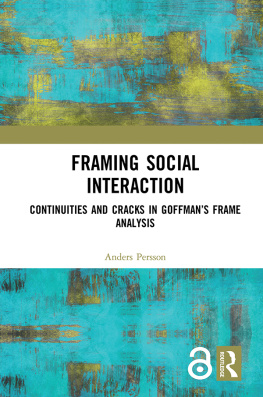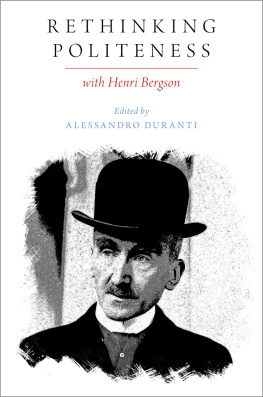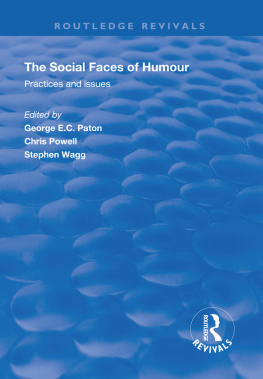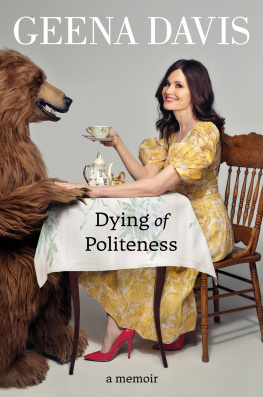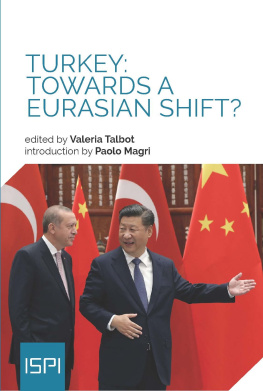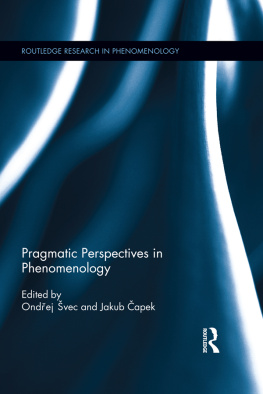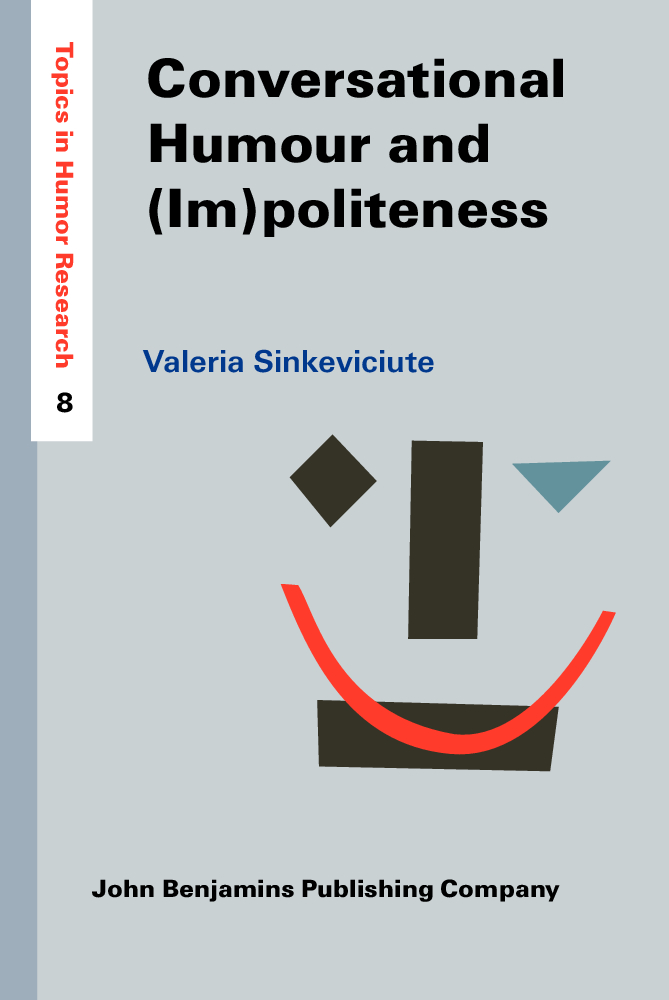

Conversational Humour and (Im)politeness
A pragmatic analysis of social interaction
Valeria Sinkeviciute
doi: 10.1075/thr.8
ISBN: 978 90 272 6211 0 (ebook)
Cataloging-in-Publication Data available from Library of Congress:
LCCN 2019028750
2019 John Benjamins B.V.
No part of this book may be reproduced in any form, by print, photoprint, microfilm, or any other means, without written permission from the publisher.
John Benjamins Publishing Company https://benjamins.com
John Benjamins Publishing Company
Amsterdam/Philadelphia
To my grandparents
Acknowledgements
The bulk of the research reported in this book is based on my PhD thesis that was supported by a grant from the University of Antwerp, Belgium (IWS BOF UAntwerpen 2012) and by a travel grant for a research stay in Australia from the Research Foundation Flanders (FWO V4.301.14N). I cannot express enough gratitude to Professor Jef Verschueren for all the opportunities with which he provided me, all his support and belief in me. I am also indebted to Associate Professor Marta Dynel and Professor Michael Haugh for their valuable suggestions and interest in my work.
I would also like to thank everyone at the former IPrA Research Center and the University of Antwerp, my friends worldwide, those who have agreed to be interviewed, and, of course, my family for letting me fly so far away to my new (academic) home and always being there for me.
Different parts of this volume have already been published as articles or chapters. I am grateful to Elsevier, John Benjamins and De Gruyter for granting me the permission to include that work in this book.
Finally, I would like to thank the editorial team of the Topics in Humor Research series and an anonymous reviewer for useful suggestions.
Chapter 1 Introduction
In order to give the reader an idea of what this book is about, I would like to start the first chapter with the following example that perfectly illustrates the (meta-)pragmatic phenomena that will be found on the pages of this volume. This excerpt from the 2012 British version of Big Brother begins with Sara (a housemate from Scotland) introducing the topic of the Loch Ness monster:
Sara: do you think the Loch Ness monster is a snake = like a huge huge snake =Caroline: = [shakes] =Adam: (its) a big snakeSara: there is definitely something in there its a loch that goes-Caroline: how funny is it that Sara is {[giggling] talking about the Loch Ness monster} [hehe]
Not providing a full analysis of this and the subsequent interaction, I would like to briefly go through a couple of relevant points here (marked with an arrow in the transcriptions). While the topic of the conversation the Loch Ness monster has been treated in a serious way in the first turns, Caroline seems to see the funny side of the situational context, i.e. Sara [] talking about the Loch Ness monster. She seems to be pointing out that the funniness is created by a link between Sara and the Loch Ness monster. Is what Caroline suggesting really funny? Is it only Carolines perception of what is funny? Will other housemates see the funny side of Carolines utterance? Will it be laughed at by everyone else? Or is it possible that her attempt at humour might fail and Sara could be offended by it? The continuation of the interaction can provide us with some answers:
Sara: = what- =Scott: = maybe its a bracket? () =Caroline: = [hehe] =Sara: Caroline why are you laughing?Caroline: cause the Scottish housemate is talking about the Loch Ness monster
While some of the readers might have found Carolines turn humorous and would find it harmless, when dealing with humour in multi-party interactions, there is no guarantee that ones utterance is to be perceived as funny by everyone, especially the target. That is why it is essential to observe how attempts at humour are received. In this case, Sara does not seem amused and appears to challenge Caroline by first uttering what and then explicitly asking Caroline why are you laughing?. Such Saras reaction (as opposed to, for example, her joining in the laughter) indicates that she does not share Carolines understanding of what is funny in this particular situation (the Scottish housemate [...] talking about the Loch Ness monster), probably because she perceives herself as the target (as well as taking herself maybe a little bit too seriously) and evaluates what was said as something disrespectful and offensive to herself.
Taking these several points into consideration, it is essential to mention at this stage that this book does not provide analyses of canned jokes, nor does it explain why a particular utterance might be regarded as funny or what cognitive mechanisms are involved in the interpretation of humorous practices (the fundamental work in that area is done by Attardo and Raskin among others). Rather, this book, as will be pointed out in the following sections of this introductory chapter, focuses on how humour works in its mysterious ways in interaction and how the interlocutors negotiate its presence, which inevitably manifests itself through their evaluations and the verbal choices they make based on those evaluations.
1.1 The scope of this book
This book lies in the area sociopragmatics and examines jocular behaviours in relation to the phenomena of politeness and impoliteness, two areas - humour and (im)politeness - that have been the focus of much independent research, but only recent years have seen an increasing interest in the benefits of their combination, which has marked the beginning of systematic book-length analyses (e.g. ).
Every jocular verbal act analysed in this book is part of a larger discourse that inevitably plays a significant role in how the interactants (re-)construct and negotiate meanings, try to build or maintain good relationships or sometimes use humour to question and challenge the relationships that they have already formed. Furthermore, it cannot be denied that much of interactional behaviour bears upon social norms: some forms of talk are acceptable or even highly appreciated, while others are not, and all of this is dependent on specific aspects of context. As a result, this book is not only about jocular interactional practices and (im)politeness, but also about the understanding of those sociopragmatic practices as part of a broader cultural context and the impact of those practices on interpersonal relationships.
The focus of this study is limited to potentially jocular practices from Australian and British cultural contexts. Although particular similarities or differences have been observed during the analysis and will feature on the pages of this book, it should be mentioned that the primary aim here is not to contrast or compare the two cultural contexts. Rather, this book serves to explore how jocular verbal acts and the evaluations thereof, which are approached in terms of the phenomena of (im)politeness in interaction, manifest themselves in particular situations in each of the two cultural contexts in question. Having said that, the data comparison is, however, inevitable, and some parts of the book will focus on it.
The theoretical framework employed here brings together a combination of different views on (im)politeness and humour research. This means that some parts of the analysis propose models and classifications, while others examine instances of interactional behaviours, which follows the tradition of discursive approaches that, even though selectively, have been adopted for the purpose of this research. Most importantly, this analysis is empirically driven and largely qualitative in nature. It is based on three different data sources: corpora, reality television discourse and qualitative interviews. Working with various types of data means that a variety of approaches to data analysis need to be used. Irrespective of the data type, jocular verbal behaviours are seen here as context-specific with their own situational boundaries. In other words, the behaviours that have been analysed and will be presented in this book are determined by their situational contexts and the participants involved. Thus, what is suggested here or could be deduced from the analysis yields no general claims about why a particular interactional behaviour should necessarily be funny in Australian and British cultural contexts. Nevertheless, the findings do reflect some widespread views, opinions or attitudes towards recognisable verbal behaviours in those contexts.






